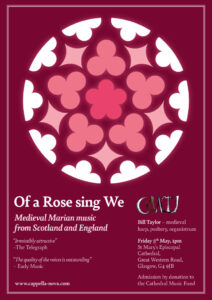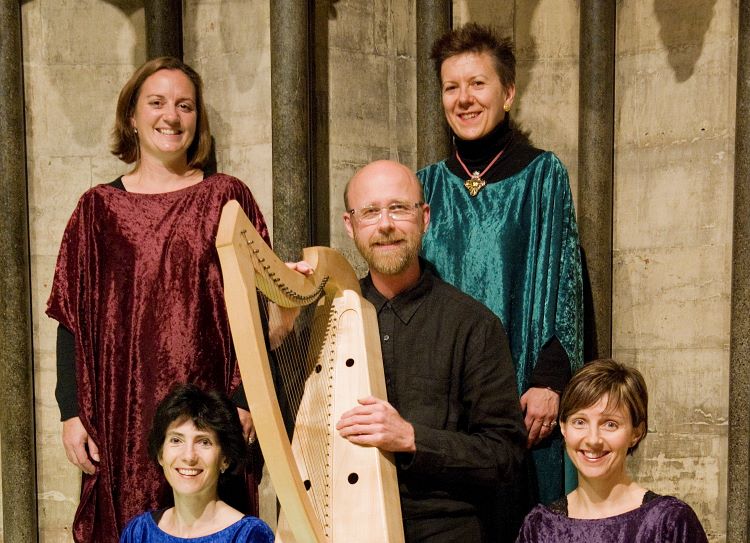Glasgow-based choir Cappella Nova, and their off-shoot all-female group Canty, has for over 40 years (!) pioneered performances and recordings of very early and very contemporary Scottish music, winning international acclaim for work that combines fine singing with careful research. This group has done much to connect contemporary Scottish vocal composition with its medieval and renaissance precursors, and are probably best known by their pioneering recordings of Scottish Renaissance composer, Robert Carver, alongside their work with Scotland’s leading modern composer, Sir James Macmillan.
This post reflects on their work specifically on the pre-1560 chant produced in Scotland, which connected Scottish-inflected Christianity with the European mainstream, in collaboration with musicologists whose recent work has done much to open up the manuscript sources for modern scholars, performers and audiences.
The role of saints in Catholic belief is to intercede in heaven for believers on specific issues, or, in the case of some figures like Mary the Mother of Christ, on a range of issues because of her nurturing, caring nature.
Before the Reformation, local saints could be celebrated in music produced by communities who had a particular affiliation to a particular figure, allowing the Proper day associated with a Saint to be marked by specific prayers and chants placed within the wider church daily liturgy of the Hours. These, the ‘Office’ associated with a saint, would recur within the annual church calendar for specific provinces, or within the type of prayer known as a ‘litany’ – a series of petitions to particular saints for their intercession. In the Scottish context, this accommodation of the local within the universal would have been helpful in the centuries when the administration of the early Culdee-mission churches was drawn into the orbit of the Church of Rome during the 12th to 13th centuries.
Although figures of significance to all Christians, such as Mary, would be acknowledged more widely in calendars, scholars have discovered that it took some effort before more local saints were fully incorporated in calendars, and their presence reflects the gradual emergence of the Scottish provinces and archdioceses as independent from English hierarchies (Hair and Knott, 2011). Celtic saints in the Scottish context constitute a claim in the 13th to 15th centuries to a regional identity that was discrete from the English, despite many elements of chant being found commonly throughout the British Isles in that period.
Based in Glasgow, it was appropriate that one early recording by Cappella Nova focussed on music associated with St Kentigern, also known as Mungo, whose missionary activity in Strathclyde in the 6th century resulted in the founding of the city and whose miracles persist in the bird, tree, bell and fish emblems on Glasgow’s city crest (Cappella Nova, 1997). The miracles of St Kentigern were celebrated in musical Office settings surviving in two early Scottish sources, one manuscript and one print (see further reading), and a feature of this recording, alongside others by this group, is that it drew on careful source-research, in this instance on the Sprouston Breviary. Hair and Knott have suggested that this particular manuscript, held by the National Library of Scotland, may have originated from the Culross area rather than Glasgow, suggesting that the saint had a following in the east of Scotland as well as the west (Hair and Knott, p.30).
Several other recordings by Cappella Nova and Canty have featured music to St Columba, who is credited with bringing Christianity to Scotland, taken from the Inchcolm Antiphoner (now in the library of the University of Edinburgh). Canty have made it their mission to search out music associated with women: women such as the medieval German Abbotess St Hildegarde von Bingen, for example, a composer as well as saint; and the Irish St Brigit of Kildare, celebrated in 15th century Offices.
In preparing music associated with St Patrick and St Brigit, Canty have worked closely with Ann Buckley of Trinity College Dublin, and are the UK partners in the AMRA chant-project. AMRA (pronounced ‘avra’) is a multi-partner EU research project led by Buckley, which aims to make available liturgical material associated with Irish saints, including saints important to the Christian mission work in Scotland. The musical flows connecting the Scottish church with Ireland are part of what made Scottish Christianity a distinctive regional culture before the 1560 Reformation.
In addition to these local saints, music was also produced in pre-Reformation Scotland dedicated to Mary, the Mother of Christ. Canty’s 2007 recording, Felix Femina, contextualised this repertoire within the Marian Mass. Masses specifically dedicated to Mary were regularly offered in sites dedicated to the virgin, while larger churches (such as St Andrews Cathedral) would have an altar or chapel dedicated to Mary for regular devotion. Prayers to Mary featured at regular points in the church calendar throughout western Europe: during Advent, Christmas, Lent. the Feast of the Annunciation, and in August, when Mary’s Assumption into heaven would have been celebrated. These different points in the church year would allow different aspects of Mary’s character and contribution to the Christian narrative to be considered.
Alongside sacred ritual, awareness of Mary shaped the secular year. ‘Lady mass’ day (the Assumption festival) – in Scots, ‘Lammas’ – was also the time for agricultural hiring fairs, which would have seen crowds gathering in market towns. Even today, some summer street festivals on towns such as St Andrews have this imprint. In this instance, ‘Lady Mass’ was probably grafted onto an older, Celtic festival marking the start of the harvest season: Lughnasadh.
Marian music arguably presented pre-Reformation Scots with opportunities to consider the feminine contribution to Christianity in ways that post-Reformation services did not, so readily. It also allowed pre-Christian fertility festivals to be absorbed within Christian practice. Many folklore tales mention musicians and dancing associated with the Gaelic celebration of Lughnasadh (Melia, 1967); the church would have needed good music to counteract the wilder opportunities available to parishioners beyond their walls.
According to Gabriel Torretta OP, pre-Reformation veneration of Mary was widespread in Scotland before a rising tide of reformist objections eroded the cult (G Torreta OP, 2014). Hector Boece’s Chronicles of Scotland (1526), for example, relate stories of Scottish piety that gave the young James V exemplars of Marian-directed prayer saving the day at critical moments in Scottish history (ibid, p.167). The same article provides more evidence for a thriving cult: poems, art commissions, chapels, shrines and pilgrimages, Books of Hours dedicated to the Virgin, all provide evidence that Mary was important to Scottish Christianity, linking Scots with wider currents of Christian belief and ritual.
This summer, Canty have been reviving this Marian material, in in association with early harpist Bill Taylor. The programme ‘Of a Rose Sing We’ was presented this May in Glasgow and London, sandwiched on either side of concert programmes dedicated to Hildegard von Bingen, performed in Edinburgh.

Further Reading and sources
(a) Manuscripts
- Sprouston Breviary – late 13th century – see National Library of Scotland Adv.MS.18.2.13B – liturgies for Kentigern, Margaret, Andrew and Ninian – the National Library notes include a bibliography on this source.
- Breviary of Aberdeen – c1508-1510, Chepman and Myllar press – another source for the Office of St Kentigern.
- Inchcolm Antiphoner, c1340 – from the Augustine Priory of Incholm, fragments of chant dedicated to Saint Columba and for the feast of Corpus Christi, now held by the University of Edinburgh.
(b) Secondary
- Ash, Marinell, ‘The Diocese of St Andrews under its ‘Norman’ Bishops’, The Scottish Historical Review 55(160), 1976, 105-126
- Buckley, Ann, ed., Music, Liturgy, and the Veneration of Saints of the Medieval Irish Church in a European Context (Turnhout: Brepols, 2017)
- Boyle, Alexander, ‘St Severanus and the Manuscript Tradition of the Life of St Kentigern’, The Innes Review, 1970, 37-45 – a survey of the manuscript records including the Office of St Kentigern
- Hair, Greta-Mary, and Knott, Betty I, Vespers, Matins and Lauds for St Kentigern, Patron Saint of Glasgow (Musica Scotica Trust, 2011)
- Melia, Daniel F, ‘The Lughnasa Musician in Ireland and Scotland’, in The Journal of American Folklore 80(318), 1967, 365-373
- Morgan, M. ‘The Organisation of the Scottish Church in the Twelfth Century’, Transactions of the Royal Historical Society 29, 1947, 135-149
- Torretta, Gabriel, OP, ‘Our Lady Reconsidered: John Knox and the Virgin Mary’, Scottish Journal of Theology 67(2), 2014, 165-177, doi:10.1017/S0036930614000040
(c) Cappella Nova / Canty Discography
- AMRA – Soundcloud recordings illustrating Celtic chant in Ireland.
- Cappella Nova, dir. Alan Tavener, ‘The Miracles of St Kentigern’ (ASV CD GAU 169, 1997) – choir accompanied by clarsach (William Taylor) and bells
- Cappella Nova, dir. Alan Tavener, ‘Columba, Most Holy of Saints’, dir. Rebecca Tavener (CDGAU 129, 1992) – music dedicated to St Columba from the Inchcolm Psalter
- Canty, dir. Rebecca Tavener, ‘Wings of Wisdom’ (Dorian Sono Luminus, DOR-93232, 2000)– chant by Hildegard von Bingen and from Scotland
- Canty, dir. Rebecca Tavener, ‘Flame of Ireland’ (Gaudeamus CD GAU 236, 2007) – 15th century chant for St Brigit of Kildare
- Canty, dir. Rebecca Tavener, ‘Felix Femina: 13th Century Scottish Polyphony’ (Gaudeamus, CD GAU 360, 2007) – contextualised within the Ladymass
- Canty, dir. Rebecca Tavener, ‘Apostle of Ireland: An Office for St Patrick’ (Divine Art, DDA 25065, 2008) – chant for St Patrick and new compositions by e.g. James Macmillan and John Tavener
- Canty, dir. Rebecca Tavener, ‘Carmina Celtica’ (Linn Records, CKD 378, 2010)

